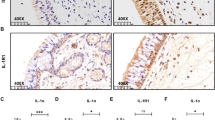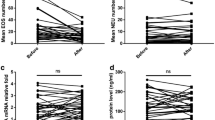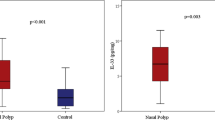Abstract
The expression and regulation of serum amyloid A (SAA) in patients with chronic rhinosinusitis with nasal polyps (CRSwNP) have not been well documented. This study enrolled 24 CRSwNP patients and 19 controls to evaluate the expression of SAA in polyp tissues in Chinese adult patients and investigate underlying mechanism. The levels of SAA and interleukin (IL)-17A and myeloperoxidase (MPO) in nasal tissues were detected using quantitative reverse transcription polymerase chain reaction (qRT-PCR) and enzyme-linked immunosorbent assay (ELISA), respectively. In addition, the mRNA expression of SAA was examined in cultured polyp epithelial cells (PECs) in the presence of various cytokines (IFN-γ, IL-4, IL-5 and IL-17A) using qRT-PCR, and the role of extracellular signal-related kinase (ERK) signalling in SAA expression was evaluated by western blot analysis. We found the levels of SAA, IL-17A and MPO were significantly upregulated in polyp tissues compared with the controls (p < 0.05), and significant correlations between SAA and IL-17A mRNA levels, as well as between SAA and MPO protein levels, were observed in polyp tissues (p < 0.05). In the in vitro culture system, IL-17A was found to significantly increase SAA mRNA expression in PECs via ERK signaling pathway, in a time- and dose-dependent manner (p < 0.05). Our results suggested a regulatory mechanism underlying excessive SAA production in polyp tissues, which might gain more insights into the pathophysiology of CRSwNP in Chinese adult patients.


Similar content being viewed by others
References
Otto BA, Wenzel SE (2008) The role of cytokines in chronic rhinosinusitis with nasal polyps. Curr Opin Otolaryngol Head Neck Surg 16:270–274
Fokkens W, Lund V, Mullol J (2007) European position paper on rhinosinusitis and nasal polyps group. European position paper on rhinosinusitis and nasal polyps 2007. Rhinology 20:S1–S136
Cao PP, Li HB, Wang BF, Wang SB, You XJ, Cui YH, Wang DY, Desrosiers M, Liu Z (2009) Distinct immunopathologic characteristics of various types of chronic rhinosinusitis in adult Chinese. J Allergy Clin Immunol 124:478–484
Wen W, Liu W, Zhang L, Bai J, Fan Y, Xia W, Luo Q, Zheng J, Wang H, Li Z, Xia J, Jiang H, Liu Z, Shi J, Li H, Xu G (2012) Increased neutrophilia in nasal polyps reduces the response to oral corticosteroid therapy. J Allergy Clin Immunol 129:1522–1528
Wang X, Dong Z, Zhu DD, Guan B (2006) Expression profile of immune-associated genes in nasal polyps. Ann Otol Rhinol Laryngol 115:450–456
Badolato R, Wang JM, Murphy WJ, Lloyd AR, Michiel DF, Bausserman LL, Kelvin DJ, Oppenheim JJ (1994) Serum amyloid A is a chemoattractant: induction of migration, adhesion, and tissue infiltration of monocytes and polymorphonuclear leukocytes. J Exp Med 180:203–209
Xu L, Badolato R, Murphy WJ, Longo DL, Anver M, Hale S, Oppenheim JJ, Wang JM (1995) A novel biologic function of serum amyloid A. Induction of T lymphocyte migration and adhesion. J Immunol 155:1184–1190
Patel H, Fellowes R, Coade S, Woo P (1998) Human serum amyloid A has cytokine-like properties. Scand J Immunol 48:410–418
Lane AP, Truong-Tran QA, Myers A, Bickel C, Schleimer RP (2006) Serum amyloid A, properdin, complement 3, and toll-like receptors are expressed locally in human sinonasal tissue. Am J Rhinol 20:117–123
Hoshino H, Laan M, Sjöstrand M, Lötvall J, Skoogh BE, Linden A (2000) Increased elastase and myeloperoxidase activity associated with neutrophil recruitment by IL-17 in airways in vivo. J Allergy Clin Immunol 105:143–149
Urieli-Shoval S, Linke RP, Matzner Y (2000) Expression and function of serum amyloid A, a major acute-phase protein, in normal and disease states. Curr Opin Hematol 7:64–69
He R, Sang H, Ye RD (2003) Serum amyloid A induces IL-8 secretion through a G protein-coupled receptor, FPRL1/LXA4R. Blood 101:1572–1581
Su SB, Gong W, Gao JL, Shen W, Murphy PM, Oppenheim JJ, Wang JM (1999) A seven-transmembrane, G protein-coupled receptor, FPRL1, mediates the chemotactic activity of serum amyloid A for human phagocytic cells. J Exp Med 189:395–402
Urieli-Shoval S, Cohen P, Eisenberg S, Matzner Y (1998) Widespread expression of serum amyloid A in histologically normal human tissues. Predominant localization to the epithelium. J Histochem Cytochem 46:1377–1384
Furlaneto CJ, Campa A (2000) A novel function of serum amyloid A: a potent stimulus for the release of tumor necrosis factor-alpha, interleukin-1beta, and interleukin-8 by human blood neutrophil. Biochem Biophys Res Commun 268:405–408
He R, Shepard LW, Chen J, Pan ZK, Ye RD (2006) Serum amyloid A is an endogenous ligand that differentially induces IL-12 and IL-23. J Immunol 177:4072–4079
Lane AP, Truong-Tran QA, Schleimer RP (2006) Altered expression of genes associated with innate immunity and inflammation in recalcitrant rhinosinusitis with polyps. Am J Rhinol 20:138–144
Acknowledgments
This study was supported by the National Natural Science Fund of China (No. U0832007, 81070771, 81070772, 81271054) and Guangdong Province Natural Science Grant (S2011010004634, S2011020002295) and a grant from the Ministry of Hygiene (No. 201202005) and Program for New Century Excellent Talents in University (No. NCET-10-0851).
Conflict of interest
No conflicts of interest to declare.
Author information
Authors and Affiliations
Corresponding authors
Additional information
H.T. Wang and J. Bai have contributed equally to this study.
Rights and permissions
About this article
Cite this article
Wang, H., Bai, J., Ding, M. et al. Interleukin-17A contributes to the expression of serum amyloid A in chronic rhinosinusitis with nasal polyps. Eur Arch Otorhinolaryngol 270, 1867–1872 (2013). https://doi.org/10.1007/s00405-012-2295-x
Received:
Accepted:
Published:
Issue Date:
DOI: https://doi.org/10.1007/s00405-012-2295-x




